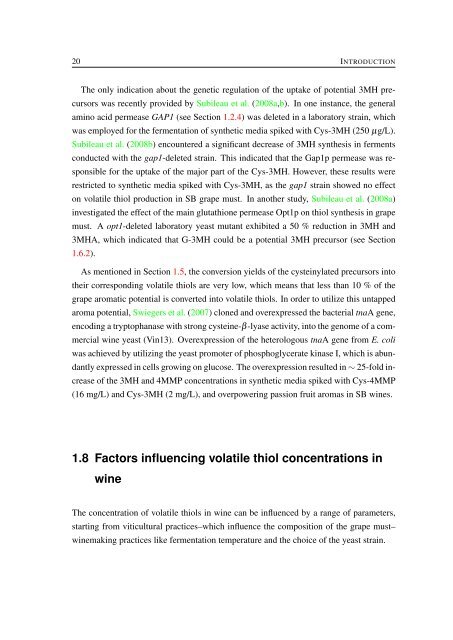Identification of yeast genes involved in Sauvignon Blanc aroma ...
Identification of yeast genes involved in Sauvignon Blanc aroma ...
Identification of yeast genes involved in Sauvignon Blanc aroma ...
Create successful ePaper yourself
Turn your PDF publications into a flip-book with our unique Google optimized e-Paper software.
20 INTRODUCTIONThe only <strong>in</strong>dication about the genetic regulation <strong>of</strong> the uptake <strong>of</strong> potential 3MH precursorswas recently provided by Subileau et al. (2008a,b). In one <strong>in</strong>stance, the generalam<strong>in</strong>o acid permease GAP1 (see Section 1.2.4) was deleted <strong>in</strong> a laboratory stra<strong>in</strong>, whichwas employed for the fermentation <strong>of</strong> synthetic media spiked with Cys-3MH (250 µg/L).Subileau et al. (2008b) encountered a significant decrease <strong>of</strong> 3MH synthesis <strong>in</strong> fermentsconducted with the gap1-deleted stra<strong>in</strong>. This <strong>in</strong>dicated that the Gap1p permease was responsiblefor the uptake <strong>of</strong> the major part <strong>of</strong> the Cys-3MH. However, these results wererestricted to synthetic media spiked with Cys-3MH, as the gap1 stra<strong>in</strong> showed no effecton volatile thiol production <strong>in</strong> SB grape must. In another study, Subileau et al. (2008a)<strong>in</strong>vestigated the effect <strong>of</strong> the ma<strong>in</strong> glutathione permease Opt1p on thiol synthesis <strong>in</strong> grapemust. A opt1-deleted laboratory <strong>yeast</strong> mutant exhibited a 50 % reduction <strong>in</strong> 3MH and3MHA, which <strong>in</strong>dicated that G-3MH could be a potential 3MH precursor (see Section1.6.2).As mentioned <strong>in</strong> Section 1.5, the conversion yields <strong>of</strong> the cyste<strong>in</strong>ylated precursors <strong>in</strong>totheir correspond<strong>in</strong>g volatile thiols are very low, which means that less than 10 % <strong>of</strong> thegrape <strong>aroma</strong>tic potential is converted <strong>in</strong>to volatile thiols. In order to utilize this untapped<strong>aroma</strong> potential, Swiegers et al. (2007) cloned and overexpressed the bacterial tnaA gene,encod<strong>in</strong>g a tryptophanase with strong cyste<strong>in</strong>e-β-lyase activity, <strong>in</strong>to the genome <strong>of</strong> a commercialw<strong>in</strong>e <strong>yeast</strong> (V<strong>in</strong>13). Overexpression <strong>of</strong> the heterologous tnaA gene from E. coliwas achieved by utiliz<strong>in</strong>g the <strong>yeast</strong> promoter <strong>of</strong> phosphoglycerate k<strong>in</strong>ase I, which is abundantlyexpressed <strong>in</strong> cells grow<strong>in</strong>g on glucose. The overexpression resulted <strong>in</strong> ∼ 25-fold <strong>in</strong>crease<strong>of</strong> the 3MH and 4MMP concentrations <strong>in</strong> synthetic media spiked with Cys-4MMP(16 mg/L) and Cys-3MH (2 mg/L), and overpower<strong>in</strong>g passion fruit <strong>aroma</strong>s <strong>in</strong> SB w<strong>in</strong>es.1.8 Factors <strong>in</strong>fluenc<strong>in</strong>g volatile thiol concentrations <strong>in</strong>w<strong>in</strong>eThe concentration <strong>of</strong> volatile thiols <strong>in</strong> w<strong>in</strong>e can be <strong>in</strong>fluenced by a range <strong>of</strong> parameters,start<strong>in</strong>g from viticultural practices–which <strong>in</strong>fluence the composition <strong>of</strong> the grape must–w<strong>in</strong>emak<strong>in</strong>g practices like fermentation temperature and the choice <strong>of</strong> the <strong>yeast</strong> stra<strong>in</strong>.














